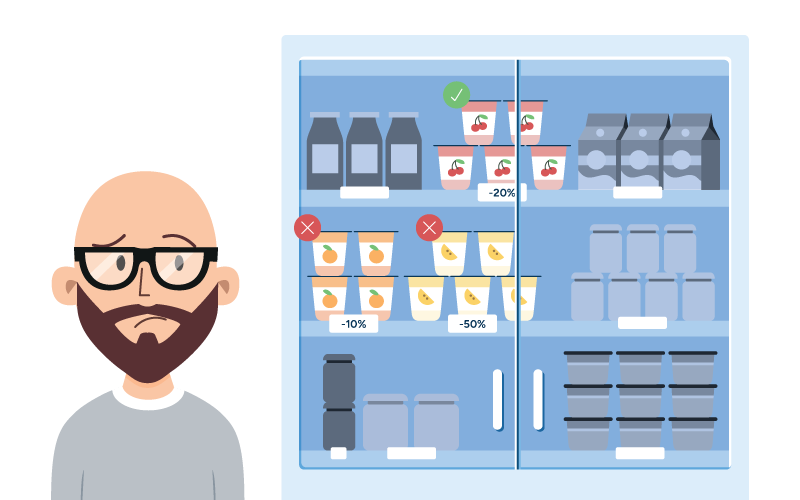Enhance assortment optimization through market basket analysis
Aug 28, 2024 • 7 min
Oftentimes puzzling out the right assortment feels like a detective game, where category planners are stuck piecing together the scattered clues of customer behavior to adopt the perfect selection of products for their store.
And just when planners are about to crack the case—a popular item gets discounted! Or shipping delays cause stockouts of shopping list staples!
While some retail giants might dive deep into personal data to try and control your shopping experience around these inventory obstacles, market basket analysis takes a more respectful route. Relying on the treasure trove of Point of Sale (POS) data and not the customers’ diaries, this approach allows retailers to optimize their assortments and keep shelves stocked with what customers love.
1. Understanding market basket analysis basics
Privacy within data management has become increasingly complex within the retail industry, especially when their data is tangled with personal customer information. Shifting privacy legalization can cause processes to double back or hit major legal bottlenecks. And while transaction trackers, like loyalty cards, are valuable sources of data, they are also fraught with privacy issues. And perhaps contrary to commonly held beliefs, personally identifiable information (PII) is not necessary for assortment management and optimization.
Many online retailers, such as Amazon, use extensive consumer data to craft their customers’ shopping experiences. In contrast, market basket analysis is an inventory approach that focuses on optimizing assortment without the need for personally identifiable information (PII).
Retailers can leverage Point of Sale (POS) data, which every retailer collects, to gain powerful insights and optimizations without the need to collect private and legally complex consumer information. This method avoids the privacy concerns associated with loyalty data, potential GDPR implications, and the increased risk of cyber-attacks that come with handling PII.
By analyzing the contents of customer shopping baskets, retailers can understand which products are frequently bought together, revealing intricate patterns and deeper relationships between products. This approach respects privacy while still providing valuable information for assortment planning and product placements.
2. Identifying product substitutes
So what can market basket analysis do for the average retailer? Take a look at product substitutions.
Figuring out product substitutes has always been a tricky but necessary part of picking the right assortment. Substitutions ensure that customers can still buy products even when their preferred products are unavailable. The difference in using market basket analysis means retailers can decide which products serve as the most effective substitutes, so customer satisfaction remains high, and no sales opportunities are lost.
The process begins with examining products that are frequently purchased in the absence of another. For instance, if customers often buy Brand A’s cereal when Brand B’s cereal is out of stock, it suggests that these products are substitutes. And if finding every ideal substitute were that easy, assortment planning and category management would be a breeze. But unfortunately, it isn’t always that simple. Some of these relationships need a deeper dive into the data to uncover.
Understanding product substitutions in depth involves analyzing thousands of overall patterns in customer purchases. By looking at historical sales data, retailers can identify patterns where specific products are consistently chosen over other alternatives. This analysis also helps in predicting how demand might shift if a product becomes temporarily unavailable or is discontinued for good.
Identifying these substitutes is not always just about direct replacements but also about understanding broader customer preferences. For example, if a specific type of pasta is unavailable, customers might switch to a different brand or pasta shape, but they also may opt out of pasta entirely and go for a similar type of product like rice or beans. Recognizing these patterns allows retailers to offer a more flexible and responsive assortment that caters to the variety of their customers’ needs.
Technology such as advanced analytics, AI, and machine learning can take the hard work out of processing these overwhelming large sets of POS data to uncover the small and subtle product relationships.
READ MORE: The need for consumer decision trees (CDTs) in assortment rationalization
3. The concept of demand transference
Once a retailer decides what their preferred product substitutes are, they also need to calculate the byproduct of the demand transference that follows. This transference of demand refers to the actual behavioral shift in customer demand from one product to another due to the unavailability of their preferred product.
Understanding this phenomenon is essential for effective inventory management and assortment optimization, as it helps retailers proactively anticipate and respond to changes in customer purchasing behavior.
Everyone knows as a retailer and a customer that when a product is out of stock or discontinued, shoppers often turn to substitute products to fulfill their needs. They’re already at the store after all, so why bother driving around town? By analyzing basket data, retailers can not only identify the preferred product substitute but also predict how demand might transfer from one product to another. Recognizing these patterns allows retailers to adjust their inventory levels early and ensure that substitute products are adequately stocked in time for the shifting waves of demand.

Demand transference insights are particularly valuable for managing inventory and planning promotions. By understanding which products are likely to experience increased demand when a substitute is unavailable, retailers can proactively stock these items to prevent stockouts and lost sales.
Promotion teams can also use this information to design targeted promotions that encourage customers to try substitute products, thereby smoothing the emotional transition when their preferred product is unavailable.
By using market basket analysis and leveraging advanced technologies, retailers can predict how demand will shift when products are unavailable, ensuring that substitute products are adequately stocked, and customer needs are met.
4. Assortment optimization with substitution insights
Once a retailer understands which products serve as substitutes for one another and how those substitutions will affect the flow of customer purchasing, retailers can design assortments that are both comprehensive and flexible. This means:
- Including a balanced mix of the primary preferred products and their substitutes.
- Ensuring that customers have alternatives available when their preferred items are out of stock.
- For example, if a specific brand of pasta is frequently substituted with another, both should be included in the assortment to cater to customer preferences.
Knowing which products are likely to be chosen as substitutes allows retailers to:
- Improve operational efficiency and enhance customer satisfaction by ensuring that popular substitutes are always available.
Assortment planning with substitution insights can also lead to:
- Better space utilization in stores.
- Strategically placing substitute products near their primary counterparts to make it easier for customers to find alternatives.
- Driving impulse purchases. The proximity of substitutes on the shelf may drive impulse purchases as the customer might sample alternatives, effectively turning some substitutes into complements.
Leveraging substitution insights for assortment optimization allows retailers to:
- Ensure high availability by maintaining at least one product from the substitute group in stock.
- Reduce spoilage and minimize inventory by optimizing the assortment within the substitute group.
- Balance the maximization of sales across the entire substitution group.
5. Leveraging AI and machine learning in market basket analysis
Advanced analytics, AI, and machine learning are game changers for market basket analysis and spotting product substitutions. These technologies enable retailers to process vast amounts of data quickly and accurately, uncovering patterns and relationships that would take ages to puzzle out manually.
In essence, these technologies can detect that customers who buy a particular flavor of yogurt A are likely to switch to another specific brand B when their preferred option is unavailable.
AI tools also enhance promotions by identifying the best ways to encourage customers to try substitutes, like figuring out which discounts work best. Retailers can rely on these technologies to continuously monitor sales data and provide quantitative predictions, updating substitution insights faster than people’s preferences shift.
AI tools can also enhance promotional strategies by identifying the most effective ways to encourage customers to try substitute products. For instance, these technologies can analyze past promotion data to determine which types of discounts or offers are most likely to drive sales of substitute items.

In addition to identifying product substitutions, AI and machine learning can also provide broader insights into customer behavior and preferences. By analyzing basket data, these technologies can reveal trends and patterns that inform a retailer’s overall assortment strategy, helping create a balanced mix of products that better meets customers’ needs.
Leveraging AI and machine learning for market basket analysis provides the tools needed to process large datasets, uncover subtle patterns, and make informed decisions about inventory management and assortment optimization. By adopting AI and machine learning, retailers can enhance their ability to meet customer needs, drive sales, and stay competitive without putting in hours of analysis.
READ MORE: How to manage product assortment ripple effects with planning software
Summarizing market basket analysis
With retailers facing intense competition, leveraging market basket analysis to calculate product substitutions is a powerful strategy for optimizing assortments. Here’s how it can drive your business forward:
- Understand customer needs: Identify which products serve as substitutes to ensure comprehensive and flexible assortments.
- Predict demand shifts: Use demand transference analysis to manage inventory effectively and plan targeted promotions.
- Enhance with AI: Automate the identification of product substitutions and gain deeper insights into customer behavior with AI and machine learning.
- Respect privacy: Optimize assortments without relying on PII, reducing the risk of data breaches and compliance issues.
- Drive growth: Embrace advanced technologies to maximize sales, minimize inventory costs, and deliver a superior shopping experience.
By adopting these strategies, retailers can navigate the complexities of modern retail and achieve long-term success.



